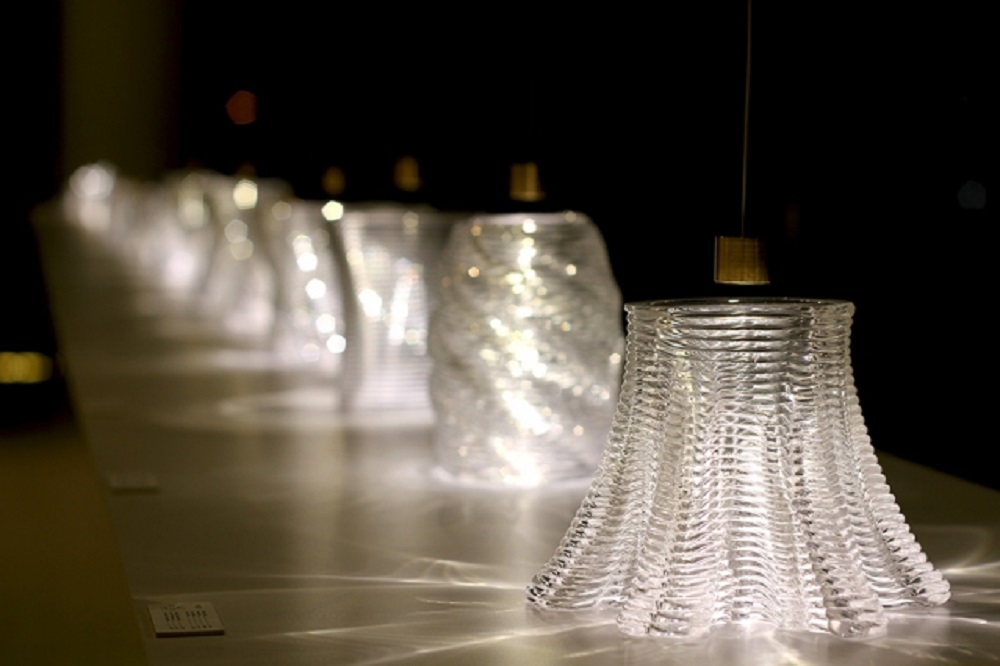
[Image above] There have been multiple developments in glass 3D printing methods since MIT debuted its prototypes from project G3DP in 2015. Credit: Chikara Inamura, MIT News Office
Though additive manufacturing (AM) is still pitched as the up-and-coming technology in contrast to traditional subtractive manufacturing techniques, certain forms of AM—particularly metal AM—are fast approaching mainstream. Yet other forms of AM are far from reaching industrial capacity.
Especially glass AM.
Two common AM methods, selective laser sintering and fused filament fabrication, both rely on raising the temperature to just under or over the starting material’s melting point so it can be molded into a desired form. For polymers, only a couple hundred degrees Celsius are required to initiate material melt. But for glass, you need temperatures well over a thousand degrees Celsius for melting to take place.
In 2015, we reported on some of the first groups to premier 3D-glass-printing technologies. In the almost four years since then, what new advances have been made in glass 3D printing?
From powder to molten glass
Prior to 2015, some groups found success 3D printing using glass powders. In these powder-based systems, an inkjet printer deposits droplets of binder solution on a thin layer of powder, and the binder and powder react to bind particles together and create a 3D object.
Then in 2015, a startup 3D printing company based in Israel called Micron3DP developed a system for 3D printing molten glass. Using a process similar to conventional fused filament fabrication techniques—except much hotter—Micron3DP created 3D objects using two types of glass: soda lime and borosilicate.
Not long after Micron3DP’s announcement, scientists from the Massachusetts Institute of Technology’s Mediated Matter group and MIT Glass Lab announced they too developed a method to heat glass to high temperatures and then 3D print the molten glass. Their project, called G3DP (Glass 3D Printing), used printed glass as both art and science.
Advances in 2017
2017 saw both Micron3DP and MIT improve on their 2015 technologies. First, in March, Micron3DP completed installation of its first fully operational high-resolution glass 3D printers inside its Kfar-Saba facility—and subsequently began negotiations for external beta testing. Then, in April, MIT demonstrated the results of G3DP2, its second glass 3D printing project, during Milan Design Week.
Yet despite the novelty of successfully 3D printing molten glass, this method of 3D printing has drawbacks—particularly poor resolution. Artistic expressions such as vases and bowls may not suffer from lack of precision, but high-tech applications requiring precise microstructures will.
Fortunately, 2017 was not limited to molten glass 3D printing advancements. Two separate groups in Germany and the United States debuted alternative glass 3D printing methods, each featuring a different technique.

Hungry for a pretzel? You may not want to take a bite out of this one—it is made from glass, using a stereolithography technique developed at the Karlsruhe Institute of Technology in Germany. Credit: Karslruhe Institute of Technology
The German group from Karlsruhe Institute of Technology used a stereolithography process to create intricate glass objects. In stereolithography, light is used to selectively harden liquid materials into solid parts, layer by layer. The team applied the stereolithography process to a special ink containing glass nanopowder suspended in a photocurable polymer, and then they fired the piece at 1,300ºC to burn off the polymer and densify the glass.
In the U.S., researchers at Lawrence Livermore National Laboratory, University of Minnesota, and Oklahoma State University also used a special ink to 3D print glass, but instead of stereolithography, their method relied on a direct ink writing process to print 3D objects at room temperature.
Where we are now
Since 2017, some groups have discontinued their work, while others—and new ones—have continued to advance glass 3D printing processes.
Micron3DP is no longer actively developing glass 3D printing, instead focusing on metal AM. In a 3D Printing Media Network interview with Micron3DP’s CTO Eran Galor, he explains that building a market for 3D-printed glass is more difficult than developing the technology. Until a suitable market emerges, “[w]e will not continue to actively develop [3D-printed glass],” Galor says.
Though industry may build according to market demand, academics are not always similarly constrained. The MIT team has continued to improve its G3DP2 system and recently published a paper describing the advancements.
On the other side of the world, another group is preparing to enter the game. Nick Birbilis and Darren Feenstra, professor and Ph.D. candidate, respectively, at Monash University in Australia, founded their company, Maple Glass Printing, as an outlet through which to file their provisional patent and seek industry partners to commercialize their glass 3D printer. Unique to their system is an emphasis on reducing glass waste, and Birbilis and Feenstra worked to specifically design a system that can handle mixed glass.
As the AM market continues to develop and as other forms of AM take off, advancements in glass 3D printing are bound to progress—and we’ll keep you informed about new developments along the way!
